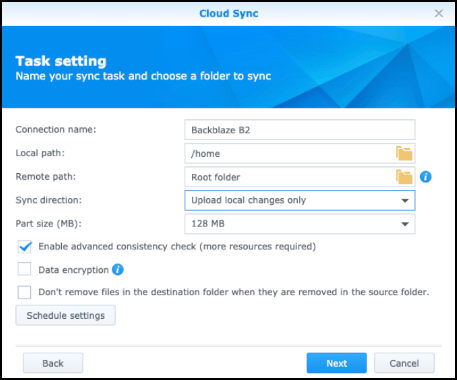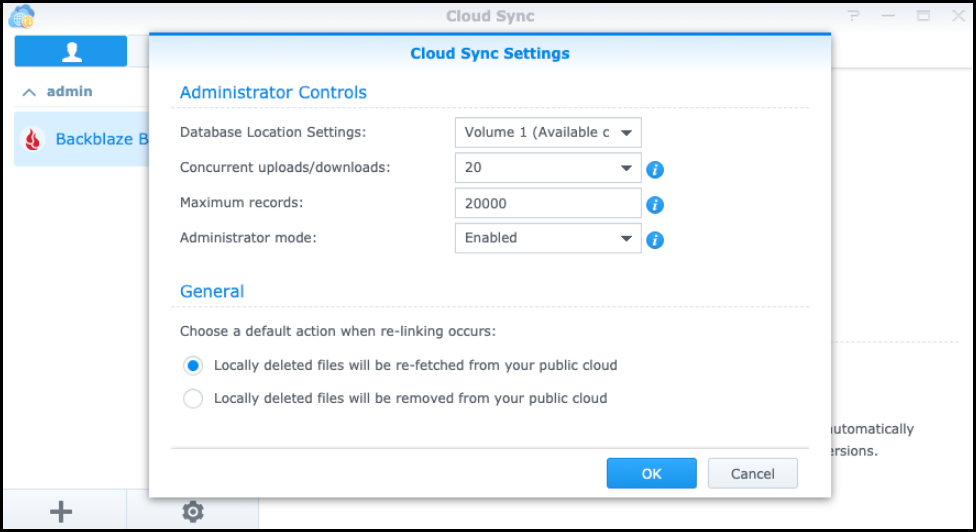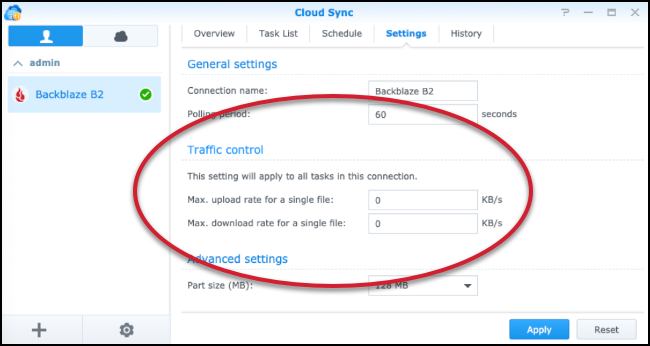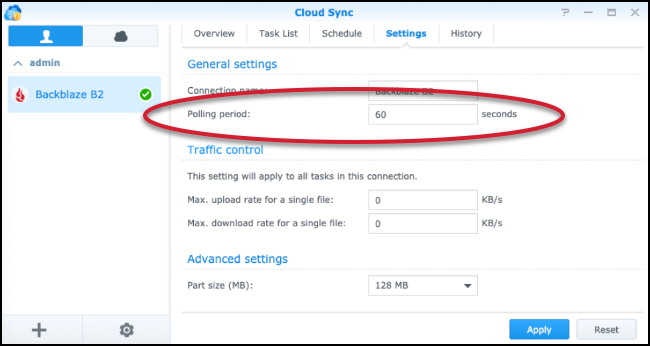- Print
- DarkLight
Synology Cloud Sync Integration with B2 Cloud Storage
- Print
- DarkLight
Synology Cloud Sync is a free tool that is built into Synology DiskStation Manager. You can configure your Synology network-attached storage (NAS) to sync files directly to your Backblaze B2 Cloud Storage bucket.
Enable Backblaze B2
Before you begin: You must have a Backblaze B2 Cloud Storage account. If you already have a Backblaze account and the left navigation menu contains a B2 Cloud Storage section, your account is already enabled for Backblaze B2.
- Sign in to the Backblaze web console.
- In the user menu in the upper-right corner of the page, select My Settings.
- Under Enabled Products, select the checkbox to enable B2 Cloud Storage.
- Review the Terms and Conditions, and click OK to accept them.
Create a Bucket
- Sign in to your Backblaze account.
- In the left navigation menu under B2 Cloud Storage, click Buckets.
- Click Create a Bucket.
- Enter a name for your bucket.
Bucket names must be at least six characters and globally unique. A message is displayed if your bucket name is already in use. - Select a privacy setting: Private or Public.
Files that are in a private bucket require authentication to perform an action, for example, downloading. Public buckets do not require authentication so you can easily share files. You can change a bucket's privacy settings at any time. - If applicable, enable a Backblaze B2 server-side encryption key.
- Click Create a Bucket, and copy the value that is in the Endpoint field; you may need this value for other processes.
- Click Lifecycle Settings to control how long to keep the files in your new bucket.
Create an Application Key
- Sign in to the Backblaze web console.
- In the left navigation menu under B2 Cloud Storage, click Application Keys.
- Click Add a New Application Key, and enter an app key name.
You cannot search an app key by this name; therefore, app key names are not required to be globally unique. Key names are limited to 100 characters and can contain letters, numbers, and "-", but not I18N characters, such as é, à, and ü. - Select All or select a specific bucket in the Allow Access to Bucket(s) menu.
- Optionally, select your access type (Read and Write, Read Only, or Write Only).
- Optionally, select Allow List All Bucket Names.
This option is required for the B2 Native API b2_list_buckets and the S3-Compatible API S3 List Buckets operations. - Optionally, enter a file name prefix to restrict application key access only to files with that prefix.
Depending on what you selected in step #4, this limits application key access to files with the specified prefix for all buckets or just the selected bucket. - Optionally, enter a positive integer to limit the time, in seconds, before the application key expires.
The value must be less than 1000 days (in seconds). - Click Create New Key, and note the resulting keyID and applicationKey values.
Install Synology Cloud Sync
Before you begin: Update Synology DiskStation Manager to version 7.0 or higher.

- Download Synology Cloud Sync from the Synology DiskStation Manager Package Center, and install the application.
- Open Synology Cloud Sync.
- Search for and select Backblaze B2 as the cloud provider.
- Enter your Application Key ID and Application Key, and select the Backblaze B2 bucket that you created for this project.
- Select task settings.
- Enter a name for your connection.
- Select the local path.
- Select the remote path.
- Select the sync direction.
- Select a part size. (Backblaze recommends a value of 128 MB.)
- Click Next, and confirm the task settings.
Your sync begins automatically.
Thread Your Upload
The Synology Cloud Sync Settings menu lets you adjust concurrent uploads and downloads. To improve performance, adjust the number of concurrent uploads. If you have fast Internet and a strong processor, increasing the number of threads can greatly reduce the total upload time.

Throttle Your Upload or Download
If Synology Cloud Sync is taking up too much bandwidth, you can set traffic control settings to set limits on maximum upload and download rates.

Edit Class C Transaction Caps
The Class C Transaction Caps are often met because the Synology sync checks for files that run often and call the Native API list_file_names operation. You can edit your Synology settings to sync less frequently, thus reducing the number of API calls that are made.

- Open Synology Cloud Sync.
- Click Settings for the connection to B2 Cloud Storage.
- In the Polling period field, input (in seconds) how frequently you want this check to occur, for example, every 1 or 12 hours.
- To edit caps in Backblaze B2, sign in to your Backblaze account.
- In the left navigation menu under B2 Cloud Storage, click Caps & Alerts.
- Click Edit Caps.
- Select the No Cap checkbox for Class C Transactions.
- Click Update Caps.
For more information about data caps and how they work, see Data Caps and Alerts.
